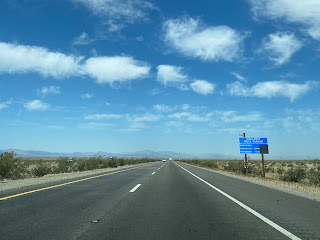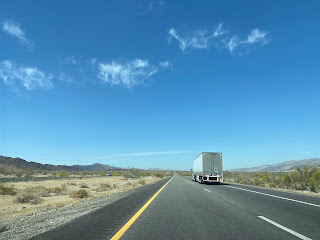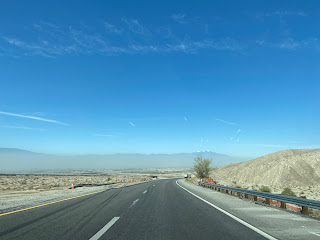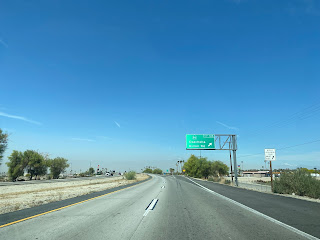Interstate 10 from the California/Arizona state line at the Colorado River to Coachella Valley passes through the rural Sonoran Desert of Riverside County. Interstate 10 was completed to freeway standards between Blythe and Coachella during the early 1970s. The Blythe-Coachella segment of Interstate 10 is historically tied to US Route 60 and US Route 70.
Part 1; the development of Interstate 10 between the Colorado River and Coachella Valley
Modernized transportation in Coachella Valley dates back to the days of the Bradshaw Trail which was a stage route originating in San Bernardino which crossed through the Sonoran Desert east to the Colorado River. During the California Gold Rush the Bradshaw Trail was plotted through the Sonoran Desert by William D. Bradshaw. The Bradshaw Trail was plotted in 1862 through the Coachella Valley and Sonoran Desert east over the Colorado River to a new mining strike found in La Paz, Arizona. Bradshaw consulted the Cahuilla Tribe who advised him of the best route east of the Salton Sink between the Orocopia Mountains and Chocolate Mountains. More information regarding the Bradshaw Trail and where to find it can be found on desertusa.com.
Below the Bradshaw Trail can be seen aligned through Coachella Valley (shown as Cabazon Valley) on the 1873 Bancroft's Map of California, Nevada, Utah and Arizona
Construction by the Southern Pacific Railroad east from Los Angeles to Arizona City (now Yuma) began during 1873. The new Southern Pacific Railroad line to Yuma would pass through San Gorgonio Pass and Coachella Valley on its course through the Sonoran Desert. The Southern Pacific Railroad would establish numerous siding facilities and communities in Coachella Valley. Indio was plotted by the Southern Pacific Railroad which reached the site of the community in 1876. Other sidings in Coachella Valley founded by the Southern Pacific Railroad included Woodspur (now Coachella) and Garnet.
Legislative Route Number 64 (LRN 64) was defined by the 1919 Third State Highway Bond act as a new State Highway from Mecca to Blythe. The general routing of LRN 64 was different from the Bradshaw Trail as it followed Box Canyon, Chiriaco Summit and Chuckwalla Valley. The general routing of LRN 64 appears for the first time on the
1920 California Highway Commission Map.
The
March 1925 California Highways & Public Works features a letter from the Automobile Club of Southern California regarding the improvements to LRN 64. The letter notes a trip on the recently graded LRN 64 took 3.5 hours to complete.
The
May 1925 California Highways & Public Works references state maintenance of LRN 64 along the Mecca-Blythe Highway as beginning on January 1, 1925. Funds for the state to directly assume maintenance of LRN 64 is noted to have been sourced from the 1923 gasoline tax law.
The
February/March 1928 California Highways & Public Works featured the opening of the Colorado River Bridge (Blythe-Ehrenburg Bridge) at the Arizona state line east of Blythe. The Colorado River Bridge opened as a Riverside County owned tolled crossing which replaced the existing ferry to Ehrenburg, Arizona.



As originally envisioned in the early drafts of US Route System what became US Route 66 in California was intended to be US Route 60. The designation of the Chicago-Los Angeles corridor was intended to carry a X0 route number given it was to denote a major east/west US Route. Ultimately the State of Kentucky petitioned to have a X0 US Route and the Chicago-Los Angeles corridor became US Route 66 in the finalized US Route System created by the American Association of State Highway Officials (AASHO) during November 1926.
US Route 60 would rapidly be extended after the US Route System was created and would come into play in California during the early 1930s. A letter from the AASHO Executive Secretary to the California State Highway Engineer dated Marth 30, 1931, noted US Route 60 had been tentatively approved to be extended to California during the AASHO Executive Committee on May 26, 1930. The approval of US Route 60 being extended to California carried the stipulation that the Colorado River Bridge in Blythe be purchased by the California Division of Highways and Arizona State Road Department. The letter noted California and Arizona had taken steps through their respective legislatures to purchase the Colorado River Bridge and the terminus of US Route 60 to be at an undisclosed location in Los Angeles.


A letter from the California State Highway Engineer to the AASHO Executive Secretary on April 13, 1931, noted legislation to purchase the Colorado River Bridge had been passed in California. The purchase of the Colorado River Bridge effectively made the extension of US Route 60 into California active. LRN 64 was extended from Blythe to the Arizona state line by way of 1931 Legislative Chapter 82.
The California State Highway Engineer submitted a recommended routing of US Route 60 to the AASHO Executive Secretary on September 8, 1931. The route description of US Route 60 show as ending in Los Angeles by way of Pomona at an undisclosed terminus. The routing of US Route 60 defined it as entering Coachella Valley via LRN 64 through Box Canyon to Mecca towards Coachella. From Coachella US Route 60 joined US Route 99/LRN 26 passing through Coachella Valley towards San Gorgonio Pass.



A September 1934 exchange of letters between the California State Highway Engineer and AASHO acknowledged US Route 70 had been extended into California with an endpoint following US Route 60 into downtown Los Angeles. The routing definition of US Route 70 indicated it would multiplex US Route 99/US Route 60 east from downtown Los Angeles to Pomona and onwards multiplexed with US 60 east to Beaumont and US Route 99/US Route 60 through San Gorgonio Pass and Coachella Valley to LRN 64 near Coachella. From Coachella US Route 70 followed US Route 60 via LRN 64 to the Arizona State Line.
The
September 1934 California Highways & Public Works announced construction on the Indio-Cutoff Spur of LRN 64 had begun. The Indio-Cutoff was to serve as a new alignment of US Route 60/US Route 70 which would enter Coachella Valley via Dillon Road and would provide a bypass to the hazards of Box Canyon.



The
1935 Division of Highways Map of Riverside County depicts the original alignment of US Route 60/US Route 70/LRN 64 east from Mecca to the Arizona state line. The US Route 99/US Route 60/US Route 70 is shown splitting in Coachella. US Route 99 split via what is Cesar Chavez Street on LRN 26 towards El Centro whereas US Route 60/US Route 70 followed Grapefruit Boulevard on LRN 64 towards Mecca and Box Canyon. From Box Canyon, US Route 60/US Route 70/LRN 64 continued east over Chiriaco Summit towards Chuckwalla Valley. US Route 60/US Route 70/LRN 64 eastbound passed through Chuckwalla Valley along what is now Chuckwalla Valley Road towards Bylthe. Within Blythe US Route 60/US Route 70/LRN 64 followed Hobsonway to the Colorado River Bridge at the Arizona state line.


The
July 1935 California Highways & Public Works featured the opening of the Indio-Cutoff and realignment of US Route 60/US Route 70 onto the new spur of LRN 64. The Indio-Cutoff is stated to have opened during June 1935 five months ahead of schedule. The Indio-Cutoff is stated to be 9 miles shorter than the original alignment of US Route 60/US Route 70 through Box Canyon. Despite Box Canyon no longer being part of US Route 60/US Route 70, it would remain under State maintenance.


In a letter dated October 4, 1938, the Nevada State Highway Engineer requested information from the AASHO Executive Secretary pertaining to a 1937 request to extend US Route 95 through Nevada to Blythe, California. The origin point for the proposed extension of US Route 95 is shown to be the Idaho Oregon Nevada Highway (I.O.N. Highway #456) at McDermitt at the Oregon/Neveda state line. The AASHO Executive Secretary replied on October 8, 1937, indicating that the Oregon Department of Transportation stated I.O.N. #456 was not ready to facilitate modern automotive travel. The AASHO Executive Committee's opinion was to hold off on the extension of US Route 95 until I.O.N Highway #456 was completed in Oregon.

On May 20, 1939, the Nevada State Highway Engineer again petitioned the AASHO Executive Committee to extend US 95 through Nevada. The Nevada State Highway Engineer noted Nevada State Route 8 had been fully paved from Winnemucca to the Oregon State Line since 1936 and was ready to be assigned as US Route 95 despite I.O.N. Highway #456 not being completed.
The Nevada State Highway Engineer's letter was met with a reply by the AASHO Executive Secretary on May 24, 1939. The Executive Secretary stated once notification of the completion of I.O.N. Highway #456 was received from the Oregon Department of Transportation the AASHO Executive Committee would likely take action to extend US Route 95.
A letter dated June 2, 1939, from the AASHO Executive Secretary to the State Highway engineers of; California, Nevada, Oregon and Idaho noted the proposed alignment of US Route 95 south to Blythe, California. A separate letter to the Nevada State Highway Engineer notes that a last-minute request was made to extend US Route 93 south of Las Vegas to the California State Line via Searchlight over Nevada State Route 5 instead of US Route 95.
A letter dated June 10, 1939, by the AASHO Executive Secretary to the President of the AASHO states that the Nevada State Highway Engineer attempted to get US Route 95 into Nevada before the completion of I.O.N. Highway #456 under the pretenses that a like interim measure was permitted for the extension of US Route 6 to California. I.O.N Highway #456 is noted to have an anticipated completion sometime during 1940.

The AASHO Executive Secretary advised the Highway Engineers of California, Nevada, Oregon and Idaho in a letter dated July 7, 1939, that the AASHO Executive Committee approved the extension of US Route 95 to Blythe, California. US Route 95 absorbed the existing routing of California State Route 195/LRN 146 from the Nevada State Line south to US Route 60/US Route 70/LRN 64 at Hobson Way in Blythe. Upon the extension of US Route 95 into California the original California State Route 195 was deleted. The California State Route 195 number was reassigned to the former routing of US Route 60/US Route 70 via the spur of LRN 64 in Box Canyon.
On June 29, 1956, the Federal Highway Aid Act of 1956 was signed into law on the Federal Level. The Federal Highway Aid Act of 1956 was the genesis point of the Interstate Highway System which would in the coming decade sew the demise via US Route 60 and US Route 70 from the Colorado River west Coachella Valley by way of being replaced by Interstate 10.
The
November/December 1958 California Highways & Public Works noted US Route 60/US Route 70/LRN 64 from Indio-Cactus City was under study to expand to freeway standards. US Route 60/US Route 70/LRN 64 from Cactus City east to the Arizona State Line is stated to have had a freeway alignment adopted by the California Highway Commission.




US Route 95 was approved to be extended from Blythe to the Mexican border at San Luis, Arizona, by the AASHO Executive Committee on June 28, 1960. US Route 95 from Intake Boulevard multiplexed US Route 60/US Route 70 and planned Interstate 10 along Hobsonway to the Colorado River and Arizona state line. The extension of US Route 95 to the Mexican border was desired by the Arizona Highway Department and was not objected by the Division of Highways.
The
November/December 1961 California Highways & Public Works announced the new Colorado River Bridge carrying US Route 60/US Route 70/US Route 95/Interstate 10 into Arizona east of Blythe was recently completed. Construction costs for the new Colorado River Bridge were shared by the states of California and Arizona. The new span replaced the earlier 1928 structure.
The truncation of US Route 99 from Calexico to the junction of the Golden State Freeway and San Bernardino Freeway in Los Angeles was approved by the AASHO Executive Committee on June 19, 1963. The justification by the California Division of Highways to truncate US Route 99 was to avoid what the agency viewed as confusing multiplexes on the new Interstate corridors of Southern California. The truncation of US Route 99 to Los Angeles left US Route 60, US Route 70 and Interstate 10 as the multiplexed highway through Coachella Valley.
US Rout 70 was approved to be truncated from Los Angeles to US Route 95 in Blythe by AASHO on August 26, 1963. The truncation of US Route 70 left only US Route 60 and Interstate 10 as the only signed routes west of Blythe to Coachella Valley on LRN 64. LRN 64 would be dropped along with all the Legislative Route Numbers as part of the 1964 State Highway Renumbering.



The 1964 Division of Highways Map displays the impact of the 1964 State Highway Renumbering and 1963 changes to the US Route System. US Route 99 is shown truncated to Los Angeles and California State Route 86 replacing it between Indio-Heber. US Route 70 is displayed as being truncated out of Coachella Valley to US Route 95 in Blythe. Interstate 10 and US Route 60 are shown running concurrent west of Blythe to Coachella Valley.


The AASHO Executive Committee approved US Route 60 to be truncated from downtown Los Angeles to US Route 95 in Blythe on October 2nd, 1965. The truncation of US Route to Blythe left only Interstate 10 on what had been the corridor of US Route 99/US Route 60/US Route 70.


The California Highways & Public Works publication ended in 1967 prior to Interstate 10 through Indio being completed. Interstate 10 appears on the
1967 Division of Highways Map with a determined freeway routing which would bypass Indio and would connect with a planned freeway to Thermal. Interstate 10 is shown following an interim alignment through Indio from the Indio Rail Overhead along Indio Boulevard and Dillon Road to the Indio-Cutoff. Interstate 10 is shown complete following a portion of the Indio-Cutoff to the vicinity of Box Canyon Road. Interstate 10 is shown to have a determined realignment in Chuckwalla Valley in addition to Blythe. The interim alignment of Interstate 10 east of Intake Boulevard in Blythe is shown to be concurrent with US Route 60 and US Route 95 to the Colorado River Bridge.


The
1969 Division of Highways Map displays Interstate 10 being upgraded to freeway standards from Box Canyon Road east through Chuckwalla Valley. The new alignment of Interstate 10 through Chuckwalla Valley bypassed former US Route 60/US Route 70 along Chuckwalla Valley Road and Ragsdale Road in Desert Center.
On June 24, 1969, AASHO approved an Arizona Highway Department request to truncate US Route 70 from the California State Line to Globe, Arizona. The truncation of US Route 70 removed it from the multiplex of US Route 95/US Route 60 and Interstate 10 between Blythe to Quartzsite, Arizona.
During the early 1970s Interstate 10 in Coachella was upgraded to freeway standards and the bypass of Blythe was constructed. Interstate 10 is shown completed between the Colorado River west to Coachella Valley on the
1975 Caltrans Map.
AASHTO (now the American Association of State Highway Transportation Officials) deferred a Caltrans request to truncate US Route 60 between US Route 95 in Blythe and the Arizona state line on June 29, 1982. The request to truncate US Route 60 from Blythe was deferred pending a like application from Arizona. Caltrans noted in their request that US Route 60 was not signed along US Route 95/Interstate 10 east of Blythe to the Arizona state line.
US Route 60 was officially deleted in California during their
November 1982 meeting. US Route 60 was truncated from US Route 95 in Blythe to Interstate 10 near Brenda, Arizona.
Part 2; a drive on Interstate 10 from the Colorado River to Coachella Valley
Interstate 10 westbound enters Blythe, California via the Colorado River Bridge multiplexed with northbound US Route 95. Upon entering California, Interstate 10/US Route 95 pass through a California Agricultural Station.
Interstate 10/US Route 95 intersect the original surface alignment of US Route 60/US Route 70 in Blythe at Exit 242.
US Route 95 northbound departs from Interstate 10 westbound at Exit 241 at Intake Boulevard in Blythe.


Interstate 10 westbound Exit 240 at 7th Street accesses the Interstate 10 Business Route in Blythe.
Interstate 10 westbound Exit 239 in Blythe accesses Lovekin Boulevard.
Interstate 10 westbound Exit 236 in Blythe accesses California State Route 78 at Neighbours Boulevard.
Interstate 10 westbound departing Blythe is signed as 92 miles for Indio and 219 miles from Los Angeles.
Interstate 10 westbound Exit 232 accesses Airport Mesa Drive.
Interstate 10 westbound Exit 222 accesses Wiley's Well Rest Area.
Interstate 10 westbound Exit 217 accesses former US Route 60/US Route 70 at Chuckwalla Valley Road.
Interstate 10 westbound passes through Chuckwalla Valley. At Exit 201 the opposite end of Chuckwalla Valley Road and Corn Springs Road can be accessed.
Interstate 10 westbound Exit 192 accesses California State Route 177 in Desert Center.
Interstate 10 westbound Exit 189 accesses Riverside County Route R2 at Eagle Mountain Road.
Interstate 10 westbound Exit 182 accesses Red Cloud Road.
Interstate 10 westbound Exit 177 accesses Hayfield Road.
Interstate 10 westbound Exit 173 accesses Chiriaco Summit.
Interstate 10 westbound Exit 168 accesses former US Route 60/US Route 70 and the second California State Route 195 at Box Canyon Road. The same exit can also be used to access Cottonwood Springs Road north towards Joshua Tree National Park.
Interstate 10 westbound Exit 162 accesses an unnamed frontage road.
Interstate 10 westbound Exit 159 accesses the Cactus City Rest Area.
Interstate 10 westbound descends from the Cactus City Rest Area into Coachella Valley. Interstate 10 enters the city of Coachella and intersects Dillon Road at Exit 146. Dillon Road is signed as access to California State Route 86.
Interstate 10 westbound enters Indio and crosses over the northern terminus of California State Route 86.















































































































































Comments
Bradshaw's Road (I refuse to call it a trail because that was not historic) was shown to him by some of the Indians in the greater Dos Palmas area when gold miners needed it most. While the gold strike was very short-lived, the Road to La Paz as it was mainly known stayed around until the railroad came through. You can still take it, and it's a fascinating day's travel.
The other old route of course is the road through Box Canyon, which served as the gateway to the eastern Riverside County region for many years. That is a great drive and one that many boosters of the county tried to hang onto for a while. Of course, it was eventually superceded by what was then called the "Indio Cutoff" - essentially the I-10 today.